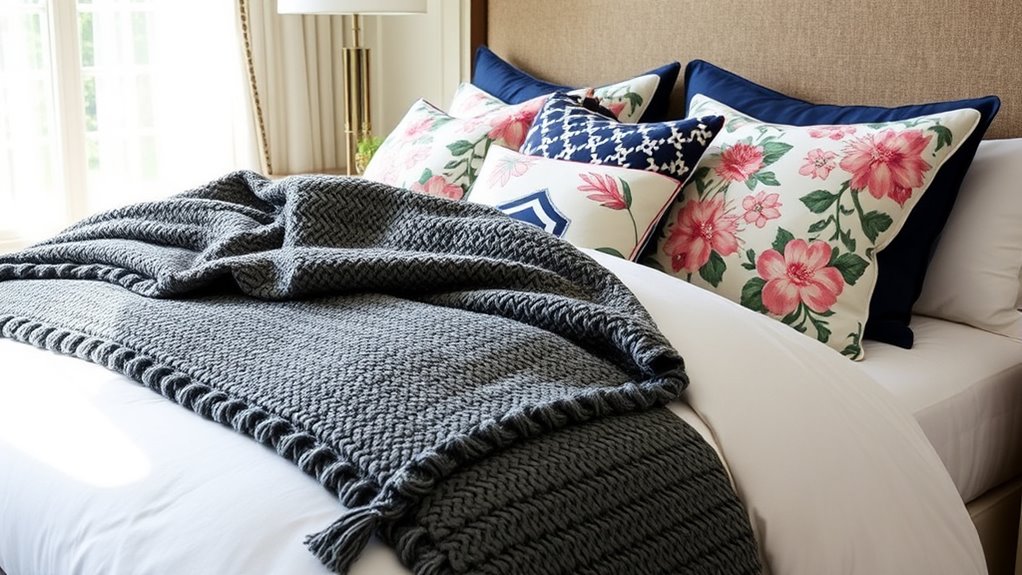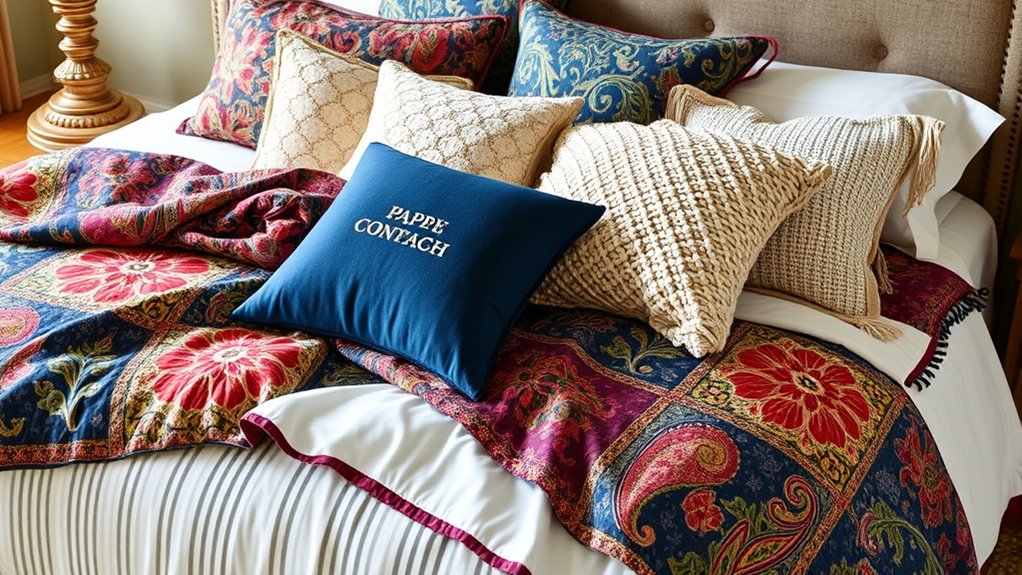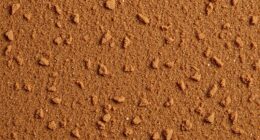To master mix-and-match bedding, focus on creating a cohesive look by blending patterns and textures thoughtfully. Use a harmonious color palette to coordinate stripes, florals, and solids, ensuring colors complement each other. Layer different fabrics like cotton, linen, velvet, or plush to add visual and tactile interest. Balancing bold and subtle elements keeps your bed inviting and stylish. Keep exploring ways to elevate your bedding ensemble for a personalized, cozy space.
Key Takeaways
- Choose a cohesive color palette to unify diverse patterns and textures effectively.
- Mix contrasting patterns like florals and stripes to create visual interest and depth.
- Layer different fabric textures such as cotton, linen, velvet, and plush for tactile richness.
- Balance vibrant and subdued patterns to maintain harmony and prevent a cluttered look.
- Use accent colors and strategic pattern placement to tie various bedding elements together seamlessly.

Have you ever considered breaking away from traditional bedding sets? Instead of sticking to a matching comforter, sheets, and pillowcases, you can create a visually engaging and cozy space by mixing and matching different patterns and textures. The key to pulling off this look lies in understanding how to balance color coordination with fabric choices. When you blend various patterns, like stripes, florals, or geometric designs, it’s essential to keep the color palette harmonious. You don’t need everything to match perfectly, but ensuring that the colors complement each other prevents the room from feeling chaotic or overwhelming. For instance, pairing a navy and white striped sheet with a floral comforter in similar tones creates contrast without clashing. Think about choosing a dominant color and then adding accent shades that tie everything together. This approach gives your bed a curated, intentional look rather than a random mishmash of patterns.
Fabric choices play a significant role in the overall feel of your layered bedding. Mixing textures like cotton, linen, velvet, or even faux fur can add depth and dimension to your bed. When selecting fabrics, consider the tactile experience you want—softer fabrics like cotton and linen are breathable and ideal for everyday comfort, while velvet or plush materials can introduce richness and luxury. Combining different textures also helps distinguish each layer, making the mix-and-match concept more dynamic. For example, a crisp cotton sheet paired with a chunky knit blanket and a silky pillowcase creates a tactile contrast that’s both inviting and visually interesting. Don’t be afraid to experiment with various fabric weights and finishes; heavier textures can ground the look, while lighter fabrics add airiness. Additionally, choosing appropriate bedding materials that align with your safety and comfort preferences, such as those with safety features or easy maintenance, can enhance your overall sleep experience.
Incorporating diverse fabric choices also allows for seasonal flexibility. You might layer light cotton sheets with a cozy wool blanket in winter, or swap out a velvet pillow for a linen one during summer. It’s about creating a layered effect that feels intentional and comfortable. When it comes to color coordination, aim for a cohesive color story rather than matching everything exactly. Use color blocking or subtle patterns to maintain harmony, even when mixing different fabrics and designs. This way, your bedding becomes a reflection of your style—vibrant and eclectic or calm and sophisticated—without feeling disorganized. Ultimately, your ability to balance color coordination with fabric choices transforms your bed from a simple necessity into a personalized, stylish retreat.
Frequently Asked Questions
How Can I Balance Bold Patterns With Subtle Textures?
To balance bold patterns with subtle textures, start by choosing a large-scale pattern that draws attention without overwhelming. Then, add bedding with a soft, understated texture to create contrast. You want to mix different pattern scales, pairing a bold, busy pattern with calmer, subtle textures. This contrast in texture and pattern scale keeps the look balanced, preventing the bold pattern from feeling too chaotic or overwhelming your space.
What Are the Best Color Combinations for Mixing Patterns?
Mixing patterns is like blending a vibrant palette—you want color pairing that creates pattern harmony. Opt for classic combinations like navy and white or soft pastels with neutral tones. Stripes with florals or checks with polka dots work well if the colors are coordinated. Stick to a cohesive color scheme, and you’ll achieve a balanced, stylish look where patterns complement rather than clash, making your bedding inviting and visually appealing.
How Do I Prevent Patterns From Clashing Visually?
To prevent patterns from clashing, focus on pattern scale and fabric contrast. Keep larger patterns balanced with smaller, more subtle ones, so they don’t overwhelm each other. Use contrasting fabrics—like smooth cotton against textured linen—to create visual interest without chaos. Stick to a cohesive color palette, and make certain that the patterns share similar tones or accents, helping everything look intentional and harmonious.
What Fabrics Work Best for Layering Different Textures?
Did you know that cotton and linen are among the most durable fabrics for layering textures? For a cozy yet resilient feel, opt for cotton, which offers excellent fabric durability, and pair it with linen for natural texture contrast. These fabrics breathe well and age beautifully, making your bedding both stylish and long-lasting. Mixing these materials creates an inviting, tactile contrast that adds depth without sacrificing comfort.
How Can I Incorporate Seasonal Trends Into Bedding Mixes?
You can incorporate seasonal trends into your bedding mixes by choosing seasonal color palettes and trending print styles. Opt for warm, earthy tones in fall, and switch to cool, pastel shades for spring. Add trending prints like florals or geometric patterns to keep things fresh. Layer different textures that complement these themes, creating a cozy yet stylish look that reflects current trends and seasonal vibes effortlessly.
Conclusion
Imagine transforming your bedroom into a cozy retreat by mixing a floral duvet with textured velvet pillows. Just like Sarah, who felt stuck in a dull space, once she layered different patterns and textures, her room became vibrant and inviting. You can achieve the same feeling—create a space that reflects your personality and sparks joy every time you walk in. Don’t be afraid to experiment; your perfect sanctuary is just a mix-and-match away.








